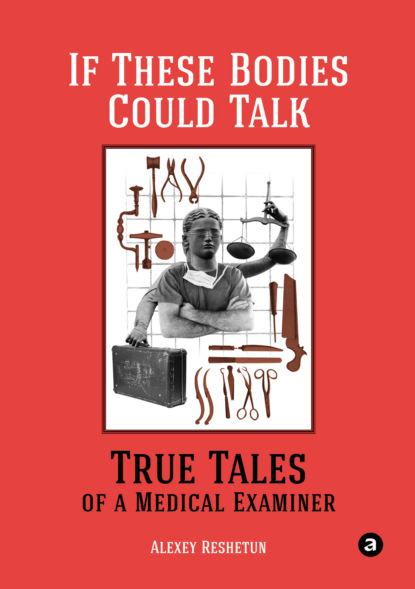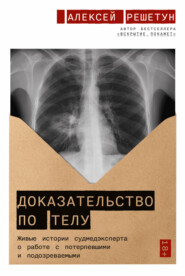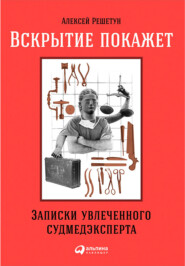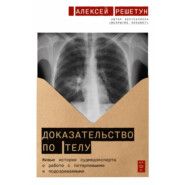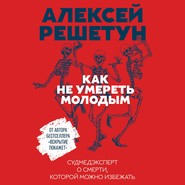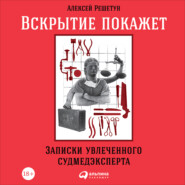По всем вопросам обращайтесь на: info@litportal.ru
(©) 2003-2024.
✖
If These Bodies Could Talk: True Tales of a Medical Examiner
Настройки чтения
Размер шрифта
Высота строк
Поля
Of course, pathologists do examine people who died at home, but only when they did so in front of witnesses (especially doctors), suffered from a long, chronic illness (confirmed by medical records), and the body did not present any sign of injury. In Russia, the number of people who die at home and are later examined by a pathologist varies among the regions – sometimes it is as high as eighty percent, and sometimes as low as ten percent.
The two most important words when describing the work of a pathologist are "disease" and "hospital." Pathologists do not examine people who died a violent death. If during a postmortem examination a pathologist sees signs of violent death, he or she must: (1) immediately stop the autopsy; and (2) contact law enforcement agencies to send the body to a medical examiner.
It is necessary to distinguish what exactly constitutes a "violent death." Most people assume that if someone is not found with an axe sticking out of their head, their death was not violent. In fact, things are not that simple. Any death that occurs due to factors in someone's external environment – cold temperatures, alcohol, carbon monoxide, or, yes, an axe wound – is considered violent. Intent does not matter here – if someone died from alcohol poisoning, whether he drank too much of his own free will, if someone poured vodka down his throat, or he drank it by accident is of little importance. In any case, the death will be considered violent.
In fact, only three types of death are considered non-violent: (1) death from disease (for example, our heart attack patient above, or someone who dies of pneumonia, a stroke, etc.); (2) death from old age (medical examiners will only see one of these cases every couple of years); and (3) death as the result of a stillbirth caused by congenital anomalies.
In short, pathologists do not examine violent deaths. That is the job of a medical examiner.
Medical examiners do not work in a hospital but in a specialized institution – in Russia's case, the Moscow Forensic-Medical Bureau. Though their offices may happen to be located in a hospital, they do not answer to the chief physician, and only examine bodies when directed to do so by law enforcement agencies. There, they handle all violent deaths (murder, suicide, accidental); sudden or unexpected deaths; deaths with no witnesses or with undetermined causes; unidentified bodies; almost all deaths involving children; and so-called "medical cases." The most important word that characterizes a medical examiner's work is "independence."
That independence is enshrined in the federal laws of the Russian Federation and numerous departmental regulations. Medical examiners do not answer to investigative authorities, the prosecution, or the defense, and they issue their conclusions based solely on their examination.
Each medical examiner must be criminally liable (!) for his or her conclusions – Article 307 of the Russian Criminal Code ensures this, and I hope that will remain the case. It is not the case for pathologists, as they are not performing medical examinations for the court.
So, what does this law mean, exactly? In short, it means that medical examiners cannot be pressured by anyone to change their conclusions, which are used as evidence in court. No department chief has the right to force any conclusions on his or her subordinates. In my sixteen years as a medical examiner, no one has ever attempted to "advise" me what to write in my reports.
Of course, that does not mean that medical examiners are immune from unscrupulous behaviors toward their duties, but every profession has its bad apples. People are only human, after all…
There are often rivalries and competition between pathologists and medical examiners, ranging from friendly to downright contemptuous. Pathologists sometimes claim that medical examiners' work is just rough and approximate guesses, while theirs is a form of true art. And medical examiners in return shame pathologists for their reports, which are written based on the principle of "the shorter, the better."
In reality, pathologists and medical examiners complement each other very well, especially if they have to share a morgue or even a forensic laboratory (which is reasonably common). We often help each other out and give each other advice, attend joint conferences and meetings hosted by scientific associations, despite the differences between us.
Comparing pathologists and medical examiners is like comparing apples with oranges. Neither is more sound, and each simply has a different medical specialty with its specific tasks and goals.
4. TO CUT OR NOT TO CUT? THAT IS THE QUESTION
The vast majority of people have a contradictory reaction to the idea of being subjected to a postmortem forensic examination. They are horrified by the very idea of being moved around, "cut up," "gutted like a fish," or having their "organs taken apart." Most of the time, the relatives of a deceased person feel the same way. It is perfectly understandable – there is nothing glamorous about a forensic examination, and the medical examiner certainly takes no pleasure in it.
Despite all the advancements of the twenty-first century, we still have no other way to determine someone's cause of death. Sometimes, I am asked about virtual autopsies or why we cannot just use a CAT scan. In fact, that technology is sometimes used in Israel and Europe, but it has not entirely replaced the old-fashioned autopsy. While a CAT scan can show us things such as a broken bone, we will still have to cut the body in order to determine how it broke in the first place. And how else can we get samples of internal organs? Unfortunately, performing an autopsy is the only way to determine the exact cause of death, and to answer questions like when the person died, whether their injuries occurred while they were still alive and how they happened, and how likely it was that they were sustained in any given situation, etc. The relatives of the deceased need to understand that this is a necessary thing if they want to know how and why their loved one has died.
People's ideas of what happens at an autopsy are often founded on rumors, tall tales, and superficial knowledge of human anatomy (recently, some educated adults asked me, with straight faces, if a person's eyes fall out of their sockets when you remove the brain from their skull). It is natural, as the average person never needs to know this kind of information. But think of the movie Flashdance. We see the heroine working in a steel mill, holding her angle grinder in what has now become an iconic scene. We do not think about what went into that step in the process: how the blast furnace was designed or what sort of chemicals were added to the raw materials to make the steel. All we see is a steelworker on a hot factory floor, cutting metal. Scenes like this have come to symbolize steelworkers in our minds. Thus, when we think about surgery, we imagine a surgeon at an operating table under the harsh glow of the lamps overhead. We do not think about how the preparation for surgery began – many members of the medical staff also had a role to play in getting the patient ready; during the surgery, the surgeon is trying to anticipate any potential complications and how to avoid them. It is also how we tend to think about autopsies – we come up with a partial sketch based on stereotypes, and it is not a very pretty picture.
In fact, autopsies do not begin in a forensic laboratory but rather in the medical examiner's office, where he or she will complete the first step of reviewing any referring documents. Ideally, those documents will give the examiner a good idea of what may have happened to the person before he or she died – were they sick, did they take some sort of substance, were they beaten, was there anything suspicious about the place the body was found, etc.? That kind of information is vital for planning the next steps of the examination. Unfortunately, however, ideals are just that, and such detailed documentation is seldom encountered. Often, the information contained in the report is very scanty, if it even exists.
After the examiner has reviewed the documentation, he or she will move on to the next step – an external examination, followed by an internal one.
An external examination begins with a description of the clothes the person is wearing. If the deceased is unidentified, its description must be very detailed – any ribbons, inscriptions, prints, fasteners, pockets and their contents, any seams on the clothing are closely examined. This level of detail is necessary, as clothes can be significant for identifying a body. Sometimes, items found in someone's pockets or even the creases of their clothes will shed light on their lifestyle or health while they were alive – syringes, pills to treat various diseases, or sometimes even illegal drugs and narcotics. Any damage to the clothing or blood, vomit, semen, urine, or soil that might be on it is meticulously described and photographed. There have been cases when we were able to identify the perpetrator or the driver of a car that ran over a pedestrian simply by the foot or tire print left behind. Once the clothing has been examined, it is either returned to the deceased person's relatives or sent to the investigator for more study.
The next step is a thorough description of the body and any features it may have – tattoos, piercings, teeth, scars, pigmentations – and, of course, any injuries. If the body is unidentified, the medical examiner will create a verbal portrait of the person, measuring the width of their hands and the length of their feet. It might seem like overkill, but it is most certainly not. After an unidentified person is buried at the government's expense, the clothing, photographs, fingerprints, blood, and verbal portrait will remain behind for identification. That might happen in a month, or maybe in a year. Often, tattoos tell us a lot about a person's life or profession. I have had cases where a body was identified by the address tattooed on the person's chest. And I once examined a man who had a tattoo on his foot of a toe tag with the inscription "Hey, you at the morgue!" (Photo 1 (https://alpinabook.ru/images/vskrytie-pokazhet-eng/?from_quick_search=#1)).
Here and elsewhere in the book are links for the photographs. Warning! The publisher does not recommend this material for anyone of a sensitive disposition.
Only once the external examination is complete will we move on to the step most commonly associated with a medical examiner's work – the autopsy. An internal examination must include three sections of the body – the cranial cavity, the chest cavity, and the abdominal cavity.
It is worth mentioning that any incisions made will be done with care not to be visible. For example, the incision on a person's head is done close to the nape of their neck, and the skin is then peeled forward and back, the dura mater of the brain is removed, and then the brain itself. The chest and abdominal cavities are cut with a single incision, and then, as a rule, the internal organs are removed all at once – from the tongue to the rectum. This is done because it preserves any anatomical links between the organs, and the doctor can see any injuries or pathological processes better. If necessary, the spine will be cut in order to examine the spinal cord, limbs, etc. Though medical examiners are not limited in the number of incisions they make or how deep or long they can be, or where, none of us will make an incision that will leave a visible mark on the body unless we truly have to. On the contrary, we strive to minimize any cuts we make. There are many ways to remove internal organs, and several of them involve just a tiny incision. In some cultures, young unmarried women are often buried in a wedding dress with a low neckline. In these cases, while performing the examination, the medical examiner will take pains to respect the family's wishes. After he or she has finished, all of the incisions will be sewn up, and sometimes padded with specific material so that no blood left in the girl's blood vessels will leak onto her clothes.
During an autopsy, examiners remove biological material from the body to carry out further studies. They nearly always take samples of blood, urine, and other biological fluids to detect any presence and concentration of alcohol; pieces of internal organs for microscopic examination; and sometimes entire organs (in cases of suspected poisoning, drowning, etc.) and bones and skin in cases of injury. In some cases, the police investigator will draw up a list of what needs to be taken, while in others, it is up to the medical examiner to decide. I think the fact that occasionally organs are removed for further lab study gives some people the idea that morgues are involved in the organ trade, which could not be further from the truth. But we will talk about that a little later on.
People who are not familiar with forensics often ask me: "What do you do with the organs when you are done with them?" Hundreds of times I have explained that all organs are considered to be part of the human body, and once we are done examining them, the majority are simply put back, with some exceptions when they are needed for additional study. After that, the orderly on duty will embalm the body or sew it up, clean it, and prepare it for burial. They will dress them, make them up, and place them in a casket. Mortuary workers are actual miracle workers, and thanks to them, relatives can bury their loved ones and have an open casket funeral, even if the deceased person suffered severe injuries.
Once the examiner has finished, he or she will issue a death certificate, which allows the person's relatives to bury the body. In about a month, test results will come back, and the examiner will issue a final report – this is the part that interests the police.
So, back to our original question – to cut or not to cut?
In the case of a pathologist's examination, relatives have the right to refuse an autopsy. Legally, they are allowed to do so in these cases.
However, things are somewhat different when someone decides a forensic examination is necessary. In these cases, there is no right to refuse. As much as a medical examiner may feel empathy for the relatives of the deceased, it is not up to them whether they proceed or not. The investigator has already decided that a forensic examination must take place. Often, relatives will try to argue that the person's last will did not include an autopsy, or cite religious and ethnic reasons, or note that their loved one suffered from chronic diseases. But their efforts are in vain. The examiner is not the one who makes the decision, and he or she is obligated to examine the body. At most, we might hold off on the autopsy and send the relatives back to the investigator to ask that the body be handed back to them, but the likelihood of this happening is very slim. Over a year, the police might return one or two bodies to the family in these circumstances, and as a rule, they are almost always the bodies of children who had been very ill, who for some reason had been sent for a forensic examination.
Sometimes, cases appear obvious – an elderly person dies, and there is no suspicion of violent death. But once the examination has begun, it reveals that the person was, in fact, murdered. Remember the wisdom of Buddha – "There is no fire like passion, there is no shark like hatred, there is no snare like folly, there is no torrent like greed." Those words are more relevant than ever today.
Вы ознакомились с фрагментом книги.
Приобретайте полный текст книги у нашего партнера:
Приобретайте полный текст книги у нашего партнера:





